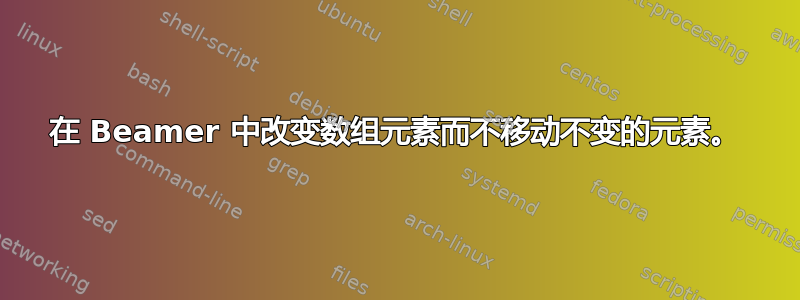
在 Beamer 演示文稿中将显示一个数组,其中某些元素在框架中的所有幻灯片中保持不变。但是,其他数组元素必须随框架中的覆盖层而变化,并且高度和宽度不恒定。似乎最好为每个变量数组条目保留一个不变的空间,其中包含类似于数组本身的内容\overlayarea,\overprint但这到目前为止还没有奏效。确实有效的命令\temporal最终会改变幻灯片之间整个数组的位置。
Beamer 中是否有针对此问题的首选和/或优雅的解决方案?
答案1
这里是 的定义和演示代码\Temporal。它的工作原理类似于,但使用了我在 中建议的\temporal框\AltBeamer alt 命令“喜欢可见”而不是“喜欢仅”。此外,我还添加了一个可选参数,可用于将较窄的替代方案对齐到左侧、中间或右侧([l],[c]或[r])。这对于支持居中数组单元是必要的。
\documentclass{beamer}
\usepackage{tikz}
\makeatletter
% Detect mode. mathpalette is used to detect the used math style
\renewcommand<>\Temporal[4][l]{%
\begingroup
\ifmmode
\expandafter\mathpalette
\expandafter\math@Temporal
\else
\expandafter\make@Temporal
\fi
{{#2}{#3}{#4}{#1}{#5}}%
\endgroup
}
% Un-brace the second argument (required because \mathpalette reads the three arguments as one
\newcommand\math@Temporal[2]{\math@@Temporal{#1}#2}
% Set the three arguments in boxes. The math style is given by #1. \m@th sets \mathsurround to 0.
\newcommand\math@@Temporal[4]{%
\setbox\z@ \hbox{$\m@th #1{#2}$}%
\setbox\@ne\hbox{$\m@th #1{#3}$}%
\setbox\tw@\hbox{$\m@th #1{#4}$}%
\@Temporal
}
% Un-brace the argument
\newcommand\make@Temporal[1]{\make@@Temporal#1}
% Set the two arguments into normal boxes
\newcommand\make@@Temporal[3]{%
\sbox\z@ {#1}%
\sbox\@ne{#2}%
\sbox\tw@{#3}%
\@Temporal
}
% Place one of the two boxes using \rlap and place a \phantom box with the maximum of the two boxes
\newcommand\@Temporal[2]{%
\setbox\@tempboxa\null
\ht\@tempboxa
\ifnum\ht\z@>\ht\@ne
\ifnum\ht\z@>\ht\tw@
\ht\z@
\else
\ht\tw@
\fi
\else
\ifnum\ht\@ne>\ht\tw@
\ht\@ne
\else
\ht\tw@
\fi
\fi
\dp\@tempboxa
\ifnum\dp\z@>\dp\@ne
\ifnum\dp\z@>\dp\tw@
\dp\z@
\else
\dp\tw@
\fi
\else
\ifnum\dp\@ne>\dp\tw@
\dp\@ne
\else
\dp\tw@
\fi
\fi
\wd\@tempboxa
\ifnum\wd\z@>\wd\@ne
\ifnum\wd\z@>\wd\tw@
\wd\z@
\else
\wd\tw@
\fi
\else
\ifnum\wd\@ne>\wd\tw@
\wd\@ne
\else
\wd\tw@
\fi
\fi
% The \hfil's center the content. Remove one or both of them to right or left align them:
\rlap{\hbox to \wd\@tempboxa{%
\ifx l#1\else\hfil\fi
\temporal#2%
{\box\z@}%
{\box\@ne}%
{\box\tw@}%
\ifx r#1\else\hfil\fi
}}%
\box\@tempboxa
}
\makeatother
\begin{document}
% Test the different modes and math styles
\begin{frame}<1-3>
Display:
\[
\begin{split}
\frac{dy}{dx} &= \left(\frac{2x}{x^2+1} + \frac{1}{2(x+3)} - \frac{1}{x-1}
\right)
\Temporal<2>{\frac{(x^2+1)\sqrt{x+3}}{x-1}}{y}{\int_x^y z}.
\end{split}
\]
In-Text:
\(
\frac{dy}{dx} = \left(\frac{2x}{x^2+1} + \frac{1}{2(x+3)} - \frac{1}{x-1}
\right)
\Temporal<2>{\frac{(x^2+1)\sqrt{x+3}}{x-1}}{y}{\int_x^y z}.
\)
Subscript:
\(
\frac{dy}{dx} = \left(\frac{2x}{x^2+1} + \frac{1}{2(x+3)} - \frac{1}{x-1}
\right) X_{\Temporal<2>{\frac{(x^2+1)\sqrt{x+3}}{x-1}}{y}{\int_x^y z}}.
\)
\[
\frac{dy}{dx} = \left(\frac{2x}{x^2+1} + \frac{1}{2(x+3)} - \frac{1}{x-1}
\right) X_{\Temporal<2>{\frac{(x^2+1)\sqrt{x+3}}{x-1}}{y}{\int_x^y z}}.
\]
Sub-Subscript:
\(
\frac{dy}{dx} = \left(\frac{2x}{x^2+1} + \frac{1}{2(x+3)} - \frac{1}{x-1}
\right) X_{X_{\Temporal<2>{\frac{(x^2+1)\sqrt{x+3}}{x-1}}{y}{\int_x^y z}}}.
\)
\[
\frac{dy}{dx} = \left(\frac{2x}{x^2+1} + \frac{1}{2(x+3)} - \frac{1}{x-1}
\right) X_{X_{\Temporal<2>{\frac{(x^2+1)\sqrt{x+3}}{x-1}}{y}{\int_x^y z}}}.
\]
Text-mode:
XXXX \Temporal<2>{aaaaa}{Ag}{AAAA}.
\end{frame}
\begin{frame}<1-3>
\[ \left(
\begin{array}{ccc}
\Temporal<2>[r]{\frac{(x^2+1)\sqrt{x+3}}{x-1}}{y}{\int_x^y z} &
\Temporal<2>[c]{\frac{(x^2+1)\sqrt{x+3}}{x-1}}{y}{\int_x^y z} &
\Temporal<2>[l]{\frac{(x^2+1)\sqrt{x+3}}{x-1}}{y}{\int_x^y z} \\
\Temporal<2>[l]{\frac{(x^2+1)\sqrt{x+3}}{x-1}}{y}{\int_x^y z} &
\Temporal<2>[c]{\frac{(x^2+1)\sqrt{x+3}}{x-1}}{y}{\int_x^y z} &
\Temporal<2>[r]{\frac{(x^2+1)\sqrt{x+3}}{x-1}}{y}{\int_x^y z} \\
\Temporal<2>[c]{<2}{=2}{>2} &
\Temporal<2>{\int x}{\iint x}{\oint x} \\
\end{array}
\right)
\]
\end{frame}
\end{document}



(图片尺寸差异是由于不同的裁剪造成的)
答案2
马丁的解决方案非常棒!
不幸的是,至少存在一种情况,\Temporal和的\Alt表现并不如人们所愿:在数组中使用它,人们可能会对数组感兴趣,其中需要交换一些行。\Temporal会产生错误,而\temporal不会。
\documentclass{beamer}
\usepackage{tikz}
\makeatletter
% Detect mode. mathpalette is used to detect the used math style
\renewcommand<>\Temporal[4][l]{%
\begingroup
\ifmmode
\expandafter\mathpalette
\expandafter\math@Temporal
\else
\expandafter\make@Temporal
\fi
{{#2}{#3}{#4}{#1}{#5}}%
\endgroup
}
% Un-brace the second argument (required because \mathpalette reads the three arguments as one
\newcommand\math@Temporal[2]{\math@@Temporal{#1}#2}
% Set the three arguments in boxes. The math style is given by #1. \m@th sets \mathsurround to 0.
\newcommand\math@@Temporal[4]{%
\setbox\z@ \hbox{$\m@th #1{#2}$}%
\setbox\@ne\hbox{$\m@th #1{#3}$}%
\setbox\tw@\hbox{$\m@th #1{#4}$}%
\@Temporal
}
% Un-brace the argument
\newcommand\make@Temporal[1]{\make@@Temporal#1}
% Set the two arguments into normal boxes
\newcommand\make@@Temporal[3]{%
\sbox\z@ {#1}%
\sbox\@ne{#2}%
\sbox\tw@{#3}%
\@Temporal
}
% Place one of the two boxes using \rlap and place a \phantom box with the maximum of the two boxes
\newcommand\@Temporal[2]{%
\setbox\@tempboxa\null
\ht\@tempboxa
\ifnum\ht\z@>\ht\@ne
\ifnum\ht\z@>\ht\tw@
\ht\z@
\else
\ht\tw@
\fi
\else
\ifnum\ht\@ne>\ht\tw@
\ht\@ne
\else
\ht\tw@
\fi
\fi
\dp\@tempboxa
\ifnum\dp\z@>\dp\@ne
\ifnum\dp\z@>\dp\tw@
\dp\z@
\else
\dp\tw@
\fi
\else
\ifnum\dp\@ne>\dp\tw@
\dp\@ne
\else
\dp\tw@
\fi
\fi
\wd\@tempboxa
\ifnum\wd\z@>\wd\@ne
\ifnum\wd\z@>\wd\tw@
\wd\z@
\else
\wd\tw@
\fi
\else
\ifnum\wd\@ne>\wd\tw@
\wd\@ne
\else
\wd\tw@
\fi
\fi
% The \hfil's center the content. Remove one or both of them to right or left align them:
\rlap{\hbox to \wd\@tempboxa{%
\ifx l#1\else\hfil\fi
\temporal#2%
{\box\z@}%
{\box\@ne}%
{\box\tw@}%
\ifx r#1\else\hfil\fi
}}%
\box\@tempboxa
}
\makeatother
\begin{document}
\begin{frame}<1-3>
\[ \left(
\begin{array}{ccc}
\temporal<2>{1 & 2 &3}{1 & 2 & 3\\4 & 5 & 6}{4 & 5 & 6}
\end{array}
\right)
\]
\end{frame}
\begin{frame}<1-3>
\[ \left(
\begin{array}{ccc}
\Temporal<2>{1 & 2 &3}{1 & 2 & 3\\4 & 5 & 6}{4 & 5 & 6}
\end{array}
\right)
\]
\end{frame}
\end{document}


